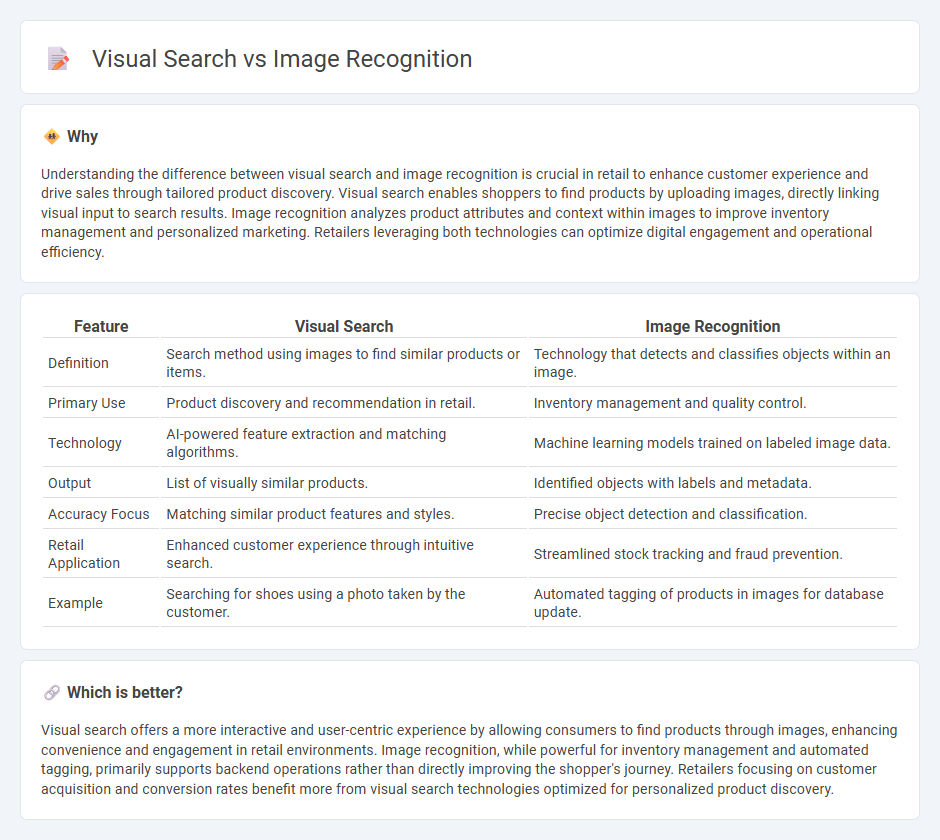
Visual search leverages artificial intelligence to analyze and interpret images, enabling consumers to find products by uploading photos rather than using text queries. Image recognition technology underpins visual search by identifying objects, patterns, and features within images to match relevant retail items accurately. Discover how integrating visual search and image recognition can revolutionize customer experience in modern retail.
Why it is important
Understanding the difference between visual search and image recognition is crucial in retail to enhance customer experience and drive sales through tailored product discovery. Visual search enables shoppers to find products by uploading images, directly linking visual input to search results. Image recognition analyzes product attributes and context within images to improve inventory management and personalized marketing. Retailers leveraging both technologies can optimize digital engagement and operational efficiency.
Comparison Table
| Feature | Visual Search | Image Recognition |
|---|---|---|
| Definition | Search method using images to find similar products or items. | Technology that detects and classifies objects within an image. |
| Primary Use | Product discovery and recommendation in retail. | Inventory management and quality control. |
| Technology | AI-powered feature extraction and matching algorithms. | Machine learning models trained on labeled image data. |
| Output | List of visually similar products. | Identified objects with labels and metadata. |
| Accuracy Focus | Matching similar product features and styles. | Precise object detection and classification. |
| Retail Application | Enhanced customer experience through intuitive search. | Streamlined stock tracking and fraud prevention. |
| Example | Searching for shoes using a photo taken by the customer. | Automated tagging of products in images for database update. |
Which is better?
Visual search offers a more interactive and user-centric experience by allowing consumers to find products through images, enhancing convenience and engagement in retail environments. Image recognition, while powerful for inventory management and automated tagging, primarily supports backend operations rather than directly improving the shopper's journey. Retailers focusing on customer acquisition and conversion rates benefit more from visual search technologies optimized for personalized product discovery.
Connection
Visual search and image recognition are intrinsically connected technologies in retail, where image recognition algorithms analyze product images to enable accurate visual search results. Retailers leverage these technologies to enhance customer experience by allowing shoppers to upload photos and instantly find matching or similar products across inventory databases. This integration boosts conversion rates and streamlines the shopping process by reducing reliance on textual queries and manual browsing.
Key Terms
Product Identification
Image recognition technology enables devices to identify objects within images using advanced algorithms and machine learning models, enhancing product identification accuracy. Visual search leverages these capabilities by allowing users to upload images or take photos to find matching products online, streamlining the shopping experience. Explore more to understand how integrating these technologies can transform e-commerce and retail strategies.
Visual Similarity Matching
Visual similarity matching is a critical technique in visual search, enabling systems to identify and retrieve images that resemble a query image based on features such as color, texture, and shape. Unlike traditional image recognition that classifies objects within an image, visual search emphasizes finding and ranking visually similar images from large datasets using deep learning algorithms and convolutional neural networks (CNNs). Explore more to understand how visual similarity matching revolutionizes e-commerce, digital asset management, and real-time image retrieval.
Automated Inventory Management
Image recognition technology analyzes visual data to identify objects, patterns, and attributes within inventory items, enabling precise categorization and tracking. Visual search leverages this recognition capability to enable users to locate products by uploading images, streamlining stock management and reducing search time. Explore how integrating these technologies revolutionizes automated inventory management for enhanced accuracy and efficiency.
Source and External Links
What is Image Recognition? | Definition from TechTarget - Image recognition is the ability of software to identify objects, places, people, writing, and actions in digital images using machine vision and AI, typically employing deep learning with neural networks trained on labeled images to predict and classify new images.
Image Recognition: Definition, Algorithms & Uses - V7 Labs - Image recognition methods include classification, detection, tagging, and segmentation to identify and localize objects within images, often using neural networks to assign categories and precise pixel-level labels.
What is Image Recognition? | IBM - Image recognition is a machine learning application where software identifies objects and actions in images or video, supporting uses like medical anomaly detection and autonomous vehicles, involving preprocessing steps like normalization and noise reduction for effective model training.
 dowidth.com
dowidth.com